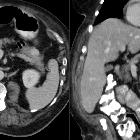somatostatinoma
Somatostatinomas are a rare type of neuroendocrine tumor. They may represent around 1% of all gastro-entero-pancreatic endocrine neoplasms.
Clinical presentation
The presentation can be variable. Patients with functional somatostatinoma may present with an "inhibitory syndrome" which is a triad of mild diabetes mellitus, cholelithiasis, and diarrhea/steatorrhea. Other lesions can present with obstructive pancreatitis.
Pathology
They typically occur in the pancreas but can also manifest in extrapancreatic organs (e.g. duodenum and ampulla of Vater) and can result in chronic obstructive pancreatitis.
Serology
They may be functional (i.e patients have high fasting somatostatin levels) or non-functional. Functional somatostatinomas can release excessive amounts of somatostatin .
Associations
- multiple endocrine neoplasia type I
- von Hippel Lindau syndrome
- duodenal somatostatinoma: neurofibromatosis type I
Radiographic features
As they share the radiographic features of other pancreatic endocrine tumors, please refer to this parental article for a detailed discussion regarding these features.
Prognosis
Most somatostatinomas are malignant and are often associated with regional and/or portal metastases at the time of diagnosis .
See also
- pancreatic neoplasms
- endocrine tumors of the pancreas
- gastrointestinal neuroendocrine tumors
- somatostatin-producing neuroendocrine tumors (SOM-NETs)
Siehe auch:

 Assoziationen und Differentialdiagnosen zu Somatostatinom:
Assoziationen und Differentialdiagnosen zu Somatostatinom:





